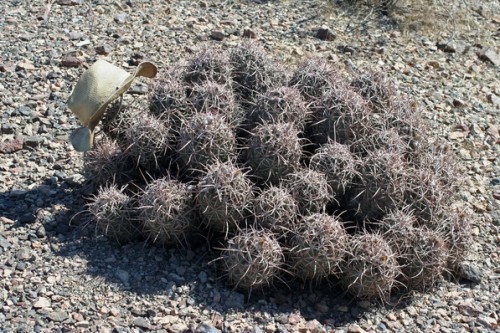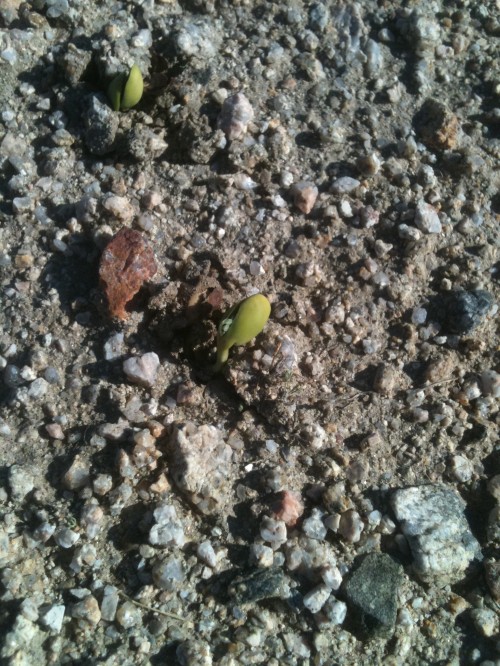About a year ago I was exploring the desert east of Joshua Tree National Park, looking for a good spot to hold a desert camping meetup for readers of Coyote Crossing, and I stopped at a little open spot not far from a mature desert ironwood tree.
It had rained a week or so beforehand, catastrophically so in some places. The storm series that came through closed major roads through the park for some months afterward. Where I stopped there was about a ten-foot earthen flood-control berm put in place to protect the (LA) Metropolitan Water District’s buried aqueduct from storm damage, and a flash flood had taken a slice out of that ten-foot berm that was as straight-sided as if it was a cake recently attacked by a knife.
The ground had recently been very wet, in other words. And when the desert soil gets wet in the late summer, interesting things happen. Winter rains are more predictable, and after a wet winter you can predictably get a pretty damn nice bloom across the desert; yellow primroses and pink desert verbena and white ghost flower covering entire bajadas that are usually shades of brown desert varnish.
But summer rains are sporadic, unpredictable, and usually very localized. A given valley in the desert might go fifty years without a good summer rain. When that valley does get a summer rain, annual plants that have been waiting in the soil seed bank for decades can come up within a few days, flower within a couple weeks, set seed and disperse that seed and die back within a month and a half. My desert botanist friends watch the weather carefully in summer, ready to plan trips out into the backcountry with the plant presses within two weeks of the drop of a hat.
The North American deserts are essentially terra incognita for botanists. There are a few things that are quite well known, because they grow and bloom during the more comfortable parts of the year within a few miles of pavement. And then there are the valleys that are a difficult day’s hike from the hearest two-rut 4WD road, and we generally don’t know what blooms there when it’s 115°F during the day because botanists are not that much more insane than the rest of us. That’s true of herpetologists and entomologists as well, and so we don’t really know some of the smaller fauna of the remote parts all that thoroughly either.
Jim André of the Sweeney Granite Mountains Desert Research Center in the Mojave Preserve tells me that if you look out at a typical Mojave Desert landscape, 10% or more of the species in your field of view aren’t known to science. He says that just about every time he goes out in the field he finds either a species or subspecies not formerly known to lie in that area, or even new to science. I’ve been in places relatively easy to get to, the California Black Hills for example, and noted plants that had not been recorded by any botanist whose records are available to the Calflora database: this tiny little cactus being one inconspicuous example:
But you find totally expected things too, like for instance on that day on which I was scouting out possible meetup campsites. A week or so after a drenching rain, in an area in which a mature ironwood tree had been dropping its leguminous seeds for some centuries, it wasn’t at all surprising to find that a couple had sprouted.
I don’t know how long the seeds had lain there before sprouting. Unlike a lot of other hard-coated desert tree seeds, ironwoods will sprout without scarification — without scratching the seed coats to let moisture in. They might have been there for six months or a century, waiting.
Ironwoods are likely my second favorite desert tree, possibly third if you count saguaros as trees. They fix nitrogen, always in short supply in the desert. They grow slowly, When they die, the wood they leave behind is — in the words of Phillips and Comus’ A Natural History of the Sonoran Desert,“rich in toxic chemicals and essentially non-biodegradable.” It’s supposed to be the second densest wood known after lignum vitae, and it’s a gorgeous chocolate color when carved and polished, which trait southwestern gift shops use to their full advantage. (The Seri Indians pioneered the art of ironwood carving using fallen wood, but the art proved so popular that others appropriated it and started cutting live trees to meet demand.)
It was a little hard to imagine that these tiny seedlings, first true leaves just starting to peek out from between the waxy cotyledons, might within a few months become some of the toughest, most enduring organisms the desert knows.
It’s been a year: I’ll have to go back and check on them.




Echinocactus polycephalus… it does look like a pile of echidnas
Let us know!
The deserts of California are, particularly at certain times of year, unbelievably gorgeous. Ridiculous levels of biodiversity, sure…this is California we’re talking about, after all. But just the wildflowers alone…California poppies may be the biggest name (and one of the most capable of producing brain-bendingly alien landscapes, when the blossoms are dense enough that it looks like the entire landscape is built on safety-cone-orange soil), but when you have flowers that are called “goldfields” based on nothing so much as the visual impact they have…yeah.
(Also: solifugae. Arachnids that may not have venom, but that just don’t give a fuck and will attack mice, cats, and toes alike. After finding one on a pile of my laundry, I developed a habit of shaking out my shoes before putting them on that persisted a year or two after I left the high desert.)
(Also also: scorpions that glow bright green under UV light. The ravers of the arachnid class!)
(Also also also: enough varieties of succulent plants to both get you drunk — agave, mezcal, pulque — and give your clothes a stylish crimson color that wars were fought over with the cochineal insects that live on prickly pear. Which is also edible. Dude, deserts rock.)
M, you remind me I need to do a post on palo verde root borers.
A little ball-of-yarn-shaped cactus that flowers in the shape of a hat. Very nice!
Watching little seedling like this sprout up is a great reminder of the power of nature. I love spring for that reason, because all the little shoots pushing up towards the sun don’t care what’s in their way. They cut right through dead leaves and push aside stones just to make it outside. We had one stubborn shoot of something-or-other try to break through the pavement on our driveway when I was growing up – even after repaving, it (or something lying quietly beside it) made a second attempt. Strong stuff, that first push through the soil…
What a remarkable privilege to witness something that probably has centuries pass between events. One would almost think that you were somehow “chosen.” (stated tongue-in-cheek)
There’s an ironwood carving of a duck I’ve had since I was a child. Never has a wood been more aptly named. I dropped it on the kitchen tile once. The tile cracked but the thin beak of the duck carving didn’t.
*like*
i can’t be the only person who assumed that “the drop of the hat” was intended to be figurative, not literal!
…WTF. I seriously did not expect that North America is so poorly known to botany.
My grandfather used to take me on long hikes and he’d always look for Carpinus caroliniana to make walking sticks.
We also called it Ironwood.
Oh, I’ll bet they sprout and get that far all the time. What’s rare is getting much bigger.
For one thing, that looks like a delicious proteinaceous treat for the next Dipsosaurus to wander by.
For another, it’s going to need more water soon and it probably won’t get it.
got data?
Not so sure about that far south, but in general the East Mojave gets predictable summer rain. The further west you go, the less likely summer rain gets.
@David – By and large, botany in North America is well studied. The mystery comes from fact that there are many areas that experience very transitory changes in environment. Getting to those areas in time to see what the changes bring can be difficult, and when the results last only a few days, there simply is no time to study them. A biology teacher in college likened it to trying to paint a portrait by strobe light, where the light would be on for only a second or two and might take anywhere from a minute to an hour between flashes.
Now I might have to find an excuse to make a trip to Tucson and do some hiking in Saguaro National Monument East…. *sigh* I miss the desert.
I have some nice pieces of carved and polished Ironwood, but I’d love to find a good Ironwood walking stick. (If anyone has links or vendors they know!)
Hunh. I’ll have to mention that to my husband. He has a “peace” pipe carved from this stuff.
I love your posts on the desert – it really takes me back. I spent part of my formative years as an ecologist in the desert (mostly Chiricahua Mts, but traveled around the SW) nearly 20 years ago, but haven’t been back since. Now in the flat, humid south I find myself really missing open Western landscapes. Your posts let me revisit the desert vicariously. Thank you!
Echinocactus polycephalus… it does look like a pile of echidnas
Very much so! Or Echinoids, or echinoderms, or any other echino- (=”spiny”) organism.
Data? This is handwaving, man!
Poorly phrased on my part: I should have said “spot” rather than “valley.” And to be really precise, I should have said something like “a seed in a particular patch of desert soil may go through [mumble] years before it receives the right combination and timing of moisture, soil temperature and other factors that will allow it to germinate.”
Toxic more to decomposing organisms, though termites do eat some ironwood. I’d be more concerned about your husband’s pipe smoldering slowly for some hours after he uses it.
Chris sez:
My palo verde root borer story.
The first summer after I moved back to Arizona, my wife (who is not from here) complained for a couple days about an odd scratching noise she heard in the bathroom. I could never hear it and the noise went away.
The next day I was alerted by a loud scream coming from the bathroom, and found her looking up in horror…dangling out of the vents in the bathroom fan were these large insect legs, clearly from something about 6″ long. ‘Twas a dead Palo Verde beetle, biggest one I’ve ever seen (and I grew up here)
Later she met some live ones, outside as they flew by majestically at head height.
We’re still living here in Arizona, amazingly enough…
@ David & Gregory: entomologically speaking, on a continent (North America) where 367 species of noctuoid moths have been described since 1983, at least the entomofauna is far less understood than we would like to believe. Of course certain ‘popular’ groups are better known than others, still, 3 swallowtail species have been described since 1990- Papilio joanae, P. canadensis and P. appalachiensis and all occurring in the well populated eastern U.S.
That should read 1980!!